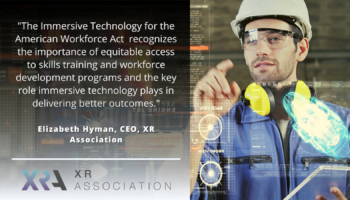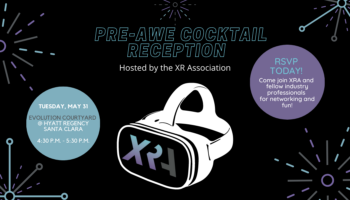Teachers believe XR technology is well-positioned to become an essential teaching tool in high school classrooms.
Washington, D.C. — The XR Association (XRA), the trade association representing the growing ecosystem of companies powering virtual, augmented, and mixed reality (XR), released results from a survey administered in partnership with the International Society for Technology in Education (ISTE) of more than 1,400 high school teachers from all 50 states, conducted to better understand the needs of educators within the XR industry.
The survey’s results point to the viability of XR technology in the classroom and its potential to advance instruction and learning in schools across the country. The use of XR in education has the potential to increase student engagement and help students develop a deeper understanding of their coursework, career skills, and each other.
“Teachers are essential to guiding the future,” said Elizabeth Hyman, CEO of the XR Association. “If teachers understand XR technology and are empowered to contribute to the way in which it is incorporated into the curriculum, everyone — students, their guardians, and the surrounding community — will be able to take advantage of its benefits.”
According to the survey, teachers believe that XR can support a variety of academic, engagement and career-related outcomes: Eighty-two percent of respondents noted that XR learning experiences are generally well-designed and deliver high-quality academic information to students; ninety-four percent of teachers believe it is important to align XR curriculums to academic standards. A solid majority of educators (67%) hope that XR technologies will be used regularly in schools.
The use of XR in the classroom has the potential to address many of the widely discussed issues in the education system today. Student motivation and morale dropped in the 2020-2021 school year and are still recovering, forcing teachers to adapt to innovative ways of classroom engagement. Seventy-seven percent of polled teachers agree that XR inspires curiosity in addition to increasing student engagement. Additionally, about three quarters of responding teachers felt that XR offered students new opportunities to explore academic concepts in depth, build career skills, and build social and empathy skills.
“To get a good sense of XR’s potential in schools, you have to ask the teachers and staff who will be administering this technology,” said Stephanie Montgomery, the XR Association’s Vice President of Research and Best Practices. “The survey’s results suggest that VR, AR and MR technology is well-positioned to become an essential teaching tool in school classrooms across the country.”
While a majority of teachers from across the country value XR technology in the classroom, some educators have legitimate concerns – such as costs and the potential long-term impact of XR use.
Earlier this month, around American Education Week, XRA published the newest chapter of its Developers Guide – a starter guide for developers designing immersive experiences. The newly released chapter titled: “Designing Immersive Learning for Secondary Education” offers a set of industry-backed best practices for creating XR programs to fit the education space and emphasizes the importance of creating programs tailored for classroom learning.
“We’ve seen how the adoption of XR technology can transform the ways in which people engage and learn, and we’re excited for what’s next,” said Brandon Olszewski, from the International Society for Technology Teachers in Education (ISTE). “Research like this is helpful as we explore the impact of technology – including XR – on the student learning experience. Given both the great promise and possible risks, more research about XR can help the field better understand the potential impact of wider use of this technology.”


ABOUT THE XR ASSOCIATION
The XR Association promotes the dynamic global growth of the XR industry, which includes virtual reality, augmented reality, mixed-reality, and future immersive technology. XRA is leading the way for the responsible development and adoption of XR by convening stakeholders, developing best practices and research, and advocating on behalf of our members and the greater XR industry.
Association members represent the headset and technology manufacturers across the broad XR industry, including Google, HTC Vive, Facebook and Oculus, Microsoft, and Sony Interactive Entertainment.





